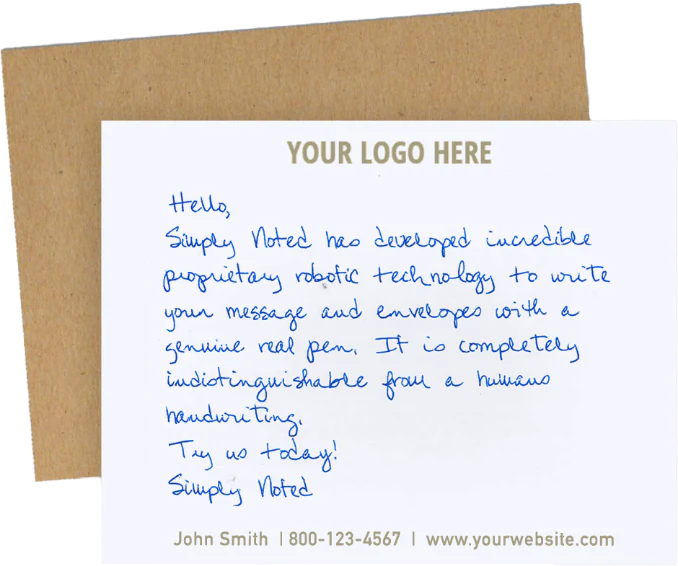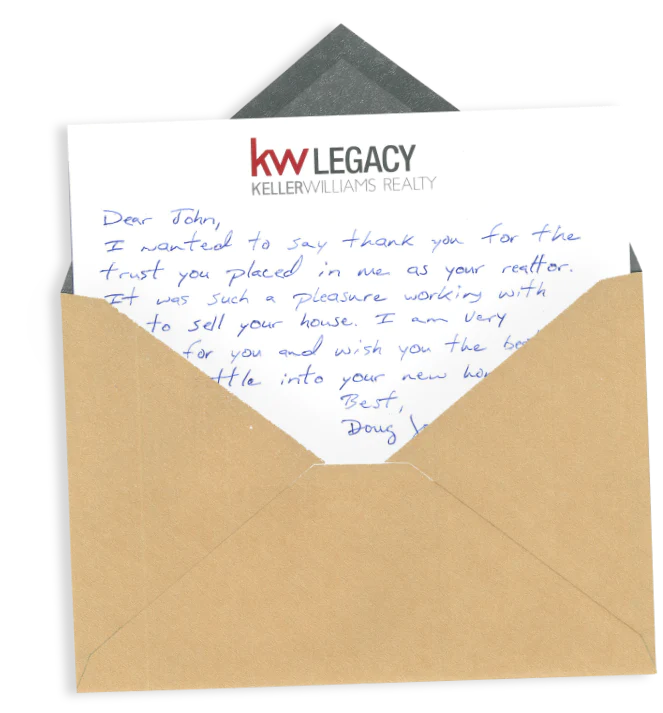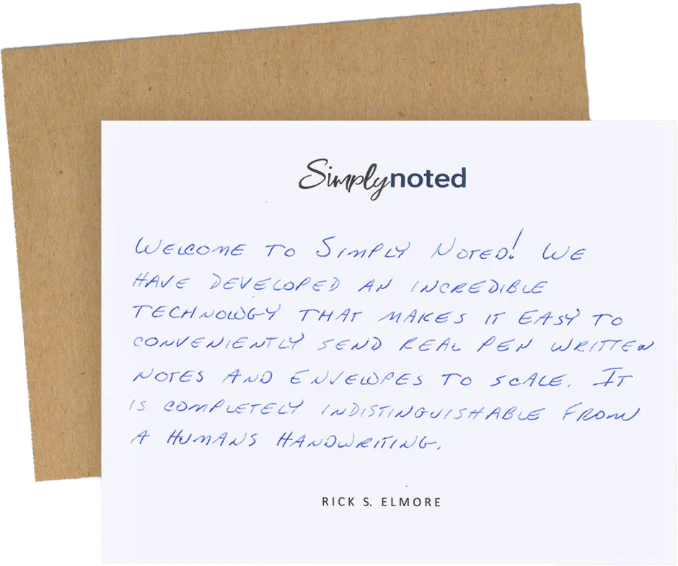How to Mail a Letter | Simply Noted

How to Mail a Letter | Simply Noted
Mailing a letter used to be a pretty simple process, but with the advent of email and other digital communication methods, it seems like handwritten notes have become a lost art. However, there are still many reasons why sending a letter might be preferable to sending an email or using some other form of digital communication. Snail mail is still the best way to reach out to someone! When you send mail through the post, people notice.
In this article, we'll discuss some of the reasons why handwritten communications are still relevant in today's digital world and how you can use this medium to keep in touch and grow your business. Finally, we'll explore how to mail off a letter in detail, from addressing the envelope to understanding mail delivery times and postal rates. By the end, you'll have a full appreciation for what goes into this tried-and-true communication method. You'll see that the ways to send letters we employ are the easiest they could be.
Why Are Handwritten Letters Still Valuable?
There are a few reasons why handwritten notes are still valuable in today's digital age. First, they offer a personal touch that you can't get with other forms of communication. Email is great for sending quick messages and digital documents, but it doesn't have the same personal feel as receiving a handwritten letter.
Second, handwritten communications can help you stand out from the crowd. With so much digital noise, it's easy for your message to get lost in the shuffle. But a handwritten card is a physical embodiment of your thoughts and feelings that will grab attention and stand out from the rest.
Businesses can get quite a bit of mileage out of handwritten notes because of the format's mind-boggling open rate — 99% of handwritten cards are opened by their recipients. There's no other marketing medium that displays such stellar performance on a consistent basis.
Finally, handwritten letters are lasting keepsakes. Unlike digital files that can be easily deleted or lost, a handwritten note is a physical object that can be kept, treasured, and sometimes displayed for years to come.
Try getting any of these with a generic email. It's simply not possible. Mailing off a letter is the better option.

How to Mail a Letter, Step by Step
Anyone can mail a letter! That process isn't difficult, nor is it expensive. One of the hallmarks of the United State Postal Service (USPS) is its ease of use and affordability. As long as you have a stamp and an address (and something to send, of course) you can post letters anywhere in the world.
Step One: Write Your Letter
The first step in the process is to write your letter. This can be done on any type of paper, but it's best to use a nice card or stationery if you have it. You'll also want to make sure that your writing is legible, as the person who receives your letter will likely take the time to read it.
The sky's the limit on how you format your communication. You could print it out from the computer, handwrite it on nice stationery, or purchase a card and write your message inside. However, you choose to do it, make sure your letter is well-written and free of any errors.
It's worth remembering that the USPS bases postal rates on the weight of the package. To qualify for the lowest first-class rate you need to keep your communication under one ounce.
Step Two: Stuff Your Envelope
Most letters should fit in an envelope. This is best, because if you use a box, which you might need to do if you're also including a gift, then your shipping costs will increase dramatically.
Ensure that you're purchasing the right size envelope for your letter. A business-sized envelope is useful for mailing large documents, particularly if you don't want to fold them. For the majority of letters and all cards and notes, though, smaller envelopes are preferable.
Place your letter inside its envelope, but don't seal it right away. It's good practice to do this last. That way you can easily remove the letter if you mess up the addresses or if you need to change something at the last minute.

Step Three: Address the Envelope
The next step is to address the envelope. This can be done by hand or with a computer printer (though by hand is FAR better — remember that 99% open rate?) If you're hand-addressing the envelope, be sure to use a nice pen, write in a straight line, and keep your penmanship clean and legible. If you have poor handwriting, you can improve your results by using large letters and writing slowly. Most mistakes happen because people are rushing.
Besides postage, the addresses are the most important features on your envelope. You need the recipient's address to tell the post office where to send your letter. The return address, your address, is less important, and can be forgone, but know that if your letter has to be returned for some reason, it can't make it back to you if you don't put your address on the card.
To ensure your mail is delivered on time (or at all) it's important to know the correct spots for each address. It's also important to use a pen with black or blue dark ink. Avoid using pencils, highlighters, or other bright colors that can be difficult to read.
Adding Your Recipient's Address
The recipient's address goes directly in the center of the front of your envelope (the side opposite the flap where you insert your note.) If you're sending to an individual, their full name goes first. If you're mailing to a company, put the company name first and then the individual recipient's name below it. You can use "c/o" or "ATTN" to denote that the letter goes to the attention or care of that person.
Below these two elements, you'll write the street address. You should try to keep this on one line, but you can split it onto two if it doesn't fit. Finally, the city, state and zip code go together on the last line.
Adding the Return Address
The return address is the location you want your mail returned to should something go wrong. The most common reasons letters are returned include incorrect postage, mistaken addresses, weight overages, or non-standard envelope shapes.
You'll write this address in the top left corner on the front of your envelope. Less commonly, though just as validly, you can put this address in the center of the back of your envelope, but this isn't preferred.

Step Four: Apply Postage
Most letters are paid for using postage. You can buy stamps in a variety of places, like the post office, grocery store, and vending kiosks. Postage stamps affix to the upper right corner of the envelope and serve as proof to your mail carrier that you paid the shipping cost. You have to weigh your letter to be sure you know exactly how much postage is required to post your letter.
The right postage changes depending on what your letter weighs and the size of your mailer. One first-class postage stamp costs $0.60 and is enough to mail a letter a single ounce or lighter. If your note weighs more, you'll need to buy postage in a larger amount or simply affix extra first-class stamps until you reach the proper postage amount. First class mail letter sending is the easiest option because all you need is a stamp. First class mail letters under an ounce as the simplest.
When purchasing first-class letters postage, opt for a forever stamp. These have no face value printed on them. As the name implies, they're good for one first-class letter forever! Even if the cost of a stamp goes up next month, the forever stamp will still be valid. If you're a business that sends a lot of mail, purchasing postage in bulk can help defray future price increases.
The stamp is also a chance to show your personality. You can choose from a wide range of designs, and both a decorative or commemorative stamp can make a nice addition to any letter.
Step Five: Post Your Letter!
At this point, you might ask, "where can I mail a letter?" To send a letter you need only find a convenient collection box. For residential customers, that's as easy as placing the completed envelope in your mailbox. Be sure to raise your box's flag if it has one to let the mailperson know there's outgoing mail inside.
Businesses usually get bulk USPS service at their location, but they can also take mail to the post office or place it in a convenient blue collection box. The postal service provides these at various points around every populated areas to ensure ease of posting.
Optional Mail Services
When sending something through the USPS, you can take advantage of a few optional services. These can enhance your mailing experience but also add to your final cost.
Insurance is one of the more important optional services. You should add this when the item you're mailing is expensive and you don't want to risk losing it in the mail. With insurance, you'll be reimbursed for the value of your mailed item should it get damaged or lost.
You can also send letters return receipt requested, which provides proof that your letter was delivered to its intended destination and recipient. This is commonly found with certified mail. Registered mail provides this proof as well, and also offers security measures like locked cages, a demonstrable chain of custody, and electronic insurance included. Priority mail express gets your letter their faster.
Packages have their own fees and delivery times. First class package service and priority versions are all good options for larger remittances.

Sending International Mail
Sending mail internationally isn't any more difficult than its domestic cousin. Postal rates will run significantly more. You can check prevailing international rates at various sites around the web. There are also certain options that are unique to international mail.
You should pay for extra postage and any fee required for optional services to send a letter. Envelopes of the same quality are fine for international use. Addressing guidelines remain the same with international mail. Your stamp doesn't move and the return address remains in the left corner.
It's important to copy the recipient address precisely. Most countries have unique address formatting rules that are easy to get wrong if you aren't paying attention. And be sure to add the destination country's name at the bottom of the address. Failing to do so can impose unnecessary delays.
How Mail Gets Delivered
Once your note is addressed and stamped, it will be sent to the local post office where it will be sorted and routed to the appropriate destination.
Post is delivered six days a week, Monday through Saturday, although some areas do not have Saturday delivery.
The US Postal Service delivers first-class mail within one to five days, although this can vary depending on the distance the communication is traveling.
Standard mail typically takes three to five days for delivery, while media mail (for items like books and DVDs) can take up to nine days. Each of these has different rates, which you can check here.

Simply Noted Makes mailing a letter much easier
If your a business that sends a high volume of mail each year, or if you're considering turning handwritten direct mail's considerable clout toward building your brand, then you need a partner to automate this arduous process.
At Simply Noted, we've built the world's most advanced handwriting computer network, with our proprietary "Infinity" fonts that recreate the subtleties of real handwriting.
You can hook your CRM and marketing software directly to our servers to allow handwritten letters to be included seamlessly in all of your marketing automation workflows.
Mailing a letter may seem like a bit of a lost art, but it can still be a convenient and effective way to communicate. By following the steps outlined above, you can ensure that your letter will be properly addressed, stamped, and delivered in a timely manner.























